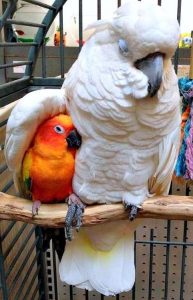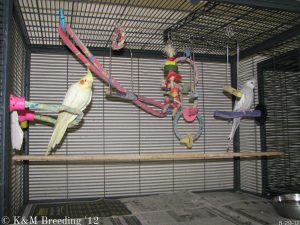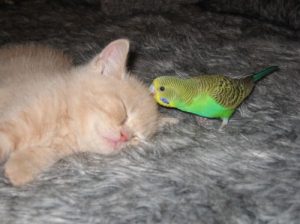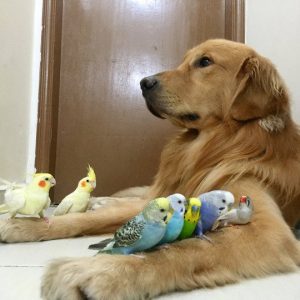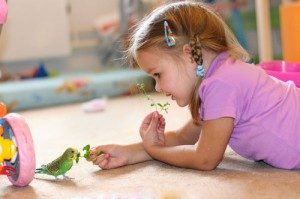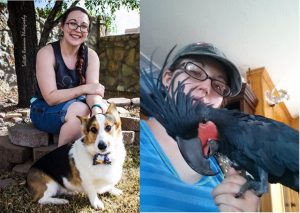As many of us begin a new school year this month, we will meet new people and create new friendships. Our companion animals may face the same thing. When coming into a new home or meeting another household member, companion birds may need some assistance from you to create these friendships and learn to live together in a happy household. There are some differences when your bird makes acquaintances with other birds, cats, dogs, and unfamiliar people. This information may help you guide your feathered companion to making fun and safe friendships.
Birds and Birds
Your first pet bird may seem a little lonely, so you may start wondering if it’s time to adopt a second feathered friend. To ensure a smooth transition with multiple birds, there are some steps that you will need to take. First of all, assess whether a second bird will be beneficial to your first pet. Ask your avian veterinarian for their opinion, and also consider your current bird’s personality.
Before bringing the new bird into the home, you will need to set up a quarantine area. Speak to your vet about how long this new bird should be separated, and know that the average quarantine time for a new bird is about 30 days. The reason for quarantine is to keep any illnesses from transferring to the first bird. Avian diseases are easily transmittable from bird to bird and they may not show symptoms until it is too severe. By keeping the new bird in quarantine, you will limit all interactions with your original bird. You will also need to be very strict on sanitation and cleaning so there is no chance of contamination to the first bird.
After quarantine, you may begin bird interactions. It is best to start slow and be very patient and to work at the speed of both birds. While the second bird is in quarantine, you can have a cage set up that this new bird will eventually go into a few feet away from the first bird’s cage. The first bird just needs to see the cage but not have any interactions with it. After quarantine, allow the second bird into its new, clean cage and give both birds time to adjust and get to know each other from a safe distance in their own space. When doing daily bird activities, it is best not to interrupt or change the first bird’s schedule. You can always introduce this schedule to the second bird. When preforming the daily actions such as feeding, cleaning, and training, always begin with the first bird. Treating the first bird as the “alpha” bird will make the addition less stressful for all.

Separate bird cages that are close enough for the two birds to see and communicate with each other but far enough apart so that they have their own space.
Once both birds seem more comfortable with each other, you can bring their cages slowly closer until they are also comfortable with that distance. Later, when they seem ready, you may add the second bird into the first bird’s cage. Give them space, but observe their behavior. They may want to stay separated from each other in this cage or they may begin to play. Let them act as birds do and figure themselves out with minimal intervention from you. If they begin to act distressed, they may not want to be housed together, but let the birds decide that for themselves. There may be some disagreements at first, but if the conflict continues without settling, it may be best for your birds to be caged separately. You will not want to be overly affectionate with one bird nor be too cuddly in front of the other. This may cause one of the birds to be overly protective of you and create jealousy between them. Give both birds equal quality time with you. This can also be done with them together. Allowing both of the birds their own space and time to become friendly with each other on their own terms may result in the best of flocked friends.
Birds and Cats
Believed to be enemies since Saturday morning cartoons, cats and birds can actually get along under the proper conditions. It would not be completely fair to any of your household companions to completely prevent access to a room that you frequent. That’s what happens if you prevent any pet from entering the bird’s room. As naturally curious creatures, cats want to explore and meet this feathered buddy that you are fascinated with. To be safe, it’s best to keep your bird in a heavy duty cage. You don’t want to have a cage that can be easily toppled over or one that can be torn apart. You need to feel comfortable for the safety of all your animals. Also, establish your bird’s cage in a corner or against a wall so, if the bird becomes uncomfortable, it can retreat to that safe area of the cage. Spend some time with both animals in the room. Keep the bird in the cage for now and just let your cat explore and smell the bird’s area. If the cat tries to bat through the cage with a paw, give them a command like “No,” or “Stop” to cease their action. You need to train your cat that it is not okay to swat at the bird. If your bird receives a bite or scratch, it can become very ill very quickly.
Once your bird becomes more comfortable with the presence of the cat, you can then start to take the bird out of it’s cage. A good way to do a face-to-face meeting between the two is to hold the bird on your hand or finger and allow the cat to approach. This way, if the animals start to get uncomfortable or too excited, you can lift the bird up and return it to it’s cage. Do not allow the cat to lick or bat at the bird at all. It may seem innocent and playful, but accidents can happen so it’s best to prevent this behavior early. Reward your cat with treats for either ignoring the bird or for gentle and calm actions. Reward your bird similarly with some of it’s favorite treats as well. With calm and repetitive actions, your cat and bird should get along fine.
Birds and Dogs
When introducing your dog to the bird, you want follow similar steps as the cat introduction. A sturdy cage and keeping your demeanor calm will make this process easy. Just the same as the cat, you want to supervise the dog’s presence around the bird while the bird is still secure in its cage. Give similar serious commands if the dog becomes too excited or tries to jump on the cage. These actions can be very threatening to a flighty bird. Once everyone seems comfortable, you can progress to holding the bird and allowing the dog to smell and meet the bird. Give the dog the same strict commands if it attempts to lick the bird or if they become a little too forceful in their curiosity. Birds may be seriously hurt from a dog bite or from being jumped upon. Reward calm and sweet behavior for both animals to reinforce proper conduct. Eventually, all animals should be able to interact safely together. It is recommended that you always supervise when your animals interact with each other for everyone’s safety.
Birds and People
Introducing birds to another person who will be living in the same household can also be complicated, but it is very similar to the process utilized with cats and dogs. Some birds, especially larger parrots, tend to bond with one person. Giving birds opportunities to make more human friends will provide greater entertainment for both species. Children, of course, will need to be closely supervised when interacting with the bird. With older people, it depends mostly on your bird’s behavior. The best way for anyone to get to know your bird is to just have them spend some time in the same space as the bird. Having the new person hang out near the bird’s cage while reading or watching television is a great way for the bird to start getting familiar with them.
Once the person and the bird are more comfortable together, you can progress to having them hold the bird. Start by having the new person hold their arm straight out horizontally and have the bird stand on their arm. This is a safe way for the bird to decide how close they want to get to this new person. In addition, the person is less likely to exhibit quick, jerky movements while attempting to pet the bird. Once the person is more comfortable and understands the bird’s behavior better, they can start to hold the bird on their hands or fingers and form a closer bond. The new person should also offer some yummy treats when the bird behaves nicely.
Patience and rewards for good behavior are an excellent way to assist your birds to become friends with many species. New friendships enrich the bird’s life by mimicking a flock mentality. It also promotes greater intelligence, and having someone new to play with is always a good thing. These new friendships should last for many years to come!
Ashley Gurnea, our Avian Editor, is a certified bird feeding specialist at Wild Birds Unlimited. A graduate from New Mexico State University, Ashley earned her bachelor degree in the field of Animal Science. She completed an internship at an exotic animal park, working with animals ranging from camels to porcupines and a variety of birds such as parrots and cockatoos. This love and curiosity of aviary has led her to her current position at Wild Birds Unlimited in Las Cruces where she remains up to date with local wild feeder birds. Growing up in a home where animals have always been present, Ashley is now a self-proclaimed “Corgi Countess” due to her love and adoration for her tricolor Pembroke welsh corgi, Colin. Bring up anything corgi or bird related in a conversation and Ashley will be happy to share her many photos. Feel free to ask her about pet birds, and visit Wild Birds Unlimited for questions on wild birds! Ashley can be reached at ashleygurnea@gmail.com.

